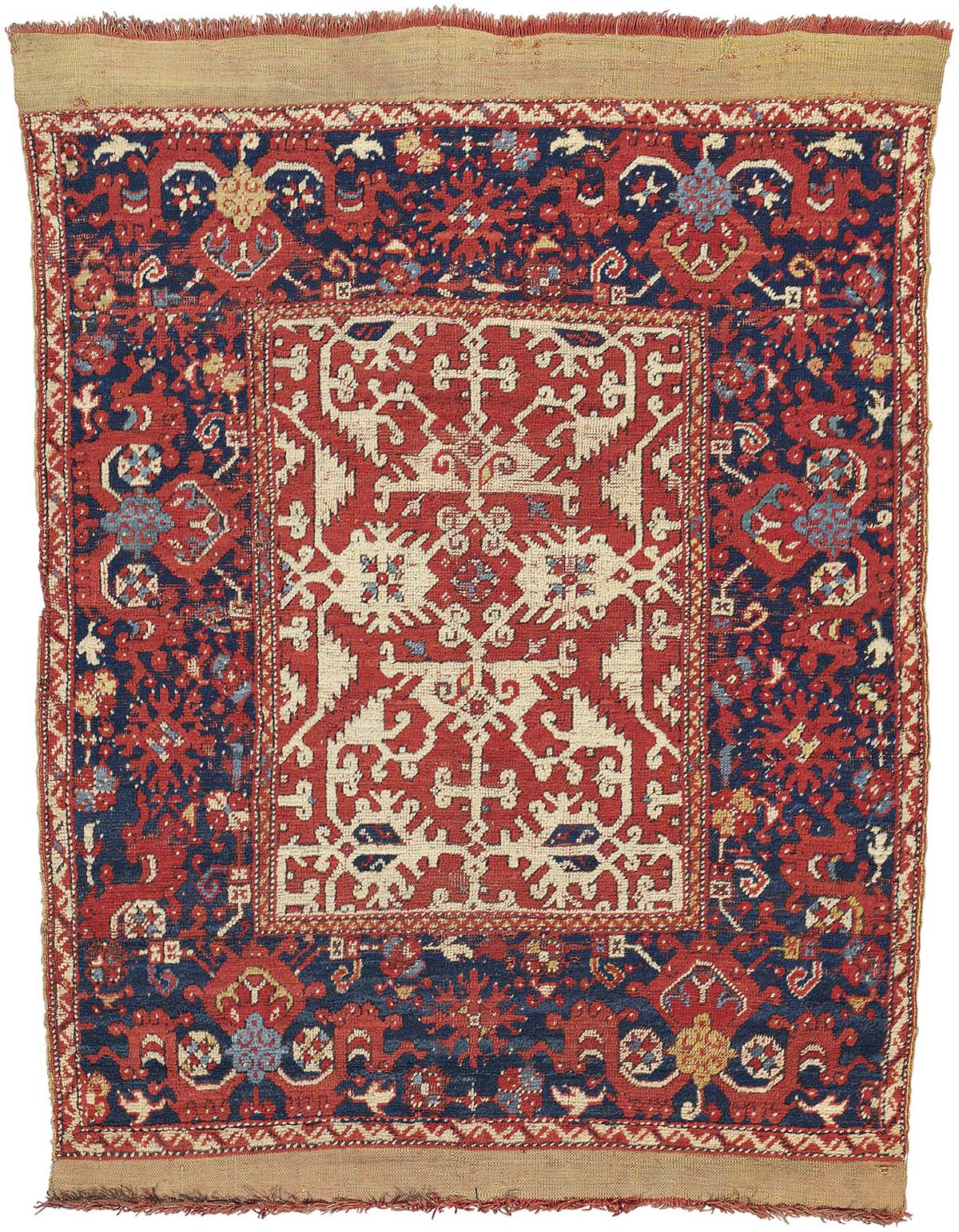|
A 'LOTTO' RUG
PROBABLY USHAK, WEST ANATOLIA, LATE 17TH CENTURY
Price
realised GBP 43,750
Christie's Sale 14217
Art of the Islamic and Indian Worlds
Including Oriental Rugs and Carpets
27 April 2017, London
Estimate
GBP 15,000 - GBP 25,000
A 'LOTTO' RUG
PROBABLY USHAK, WEST ANATOLIA, LATE 17TH CENTURY
Minor
touches of wear, naturally corroded black, a couple of minute repairs,
overall very good condition
5ft.2in. x 4ft. (156cm. x 122cm.) including
kilims
Lot essay
The popularity of the 16th century 'Lotto' design resulted in
an increased production of the type in the following century with the
majority of these, like the 'Transylvanian' rugs, being woven for the
European market. One characteristic of later examples, that developed over
the course of the century, appears to be the use of an increasingly wide
border in comparison to the field proportions. The two most frequently
encountered border types are the cartouche design and the cloud band
design as seen here. When illustrated in paintings from the period, the
rugs were generally depicted as 'table' coverings, although in some
depictions they were used on the floor. An unusual feature in this example
is that each 'cloudband' motif faces towards the field which could
indicate that it was intended to be used on a raised surface where the
border design could be viewed from all four sides. The field designs were
divided into three different groups by Grant Ellis (Charles Grant Ellis,
'The 'Lotto' Pattern as a Fashion in Carpets', in A. Ohm & H. R. (eds.),
Festschrift für Peter Wilhelm Meister zum 65. Geburstag am 16. Mai 1974,
Hamburg, 1975, pp.19-31), a division of styles which has been used almost
universally. The field of the present carpet falls into the 'kilim' style,
typified by the serrated edges of the motifs. The geometry of the design
in this example is particularly well balanced with a strong vertical axis
running through its centre, yet clearly demonstrates the endless repeat of
the pattern that sits within its imposing frame.
The present rug is
in a remarkably well-preserved condition with the majority of the pile
remaining long and lustrous where so often it has worn away completely.
The thickness of pile displays a rich palette consisting of over eight
different colours, including apricot, sea-green, light blue, indigo,
ivory, brown, black and golden yellow. Upon closer inspection, one can see
that the design is woven with small playful interchanges of colour within
each separate motif, and that each of the petals on the snow-flake like
flowerheads is tipped with a single ivory knot which highlights the motif
further, creating a glistening effect. A very similar example is housed in
the Museum of Applied Arts, Budapest, inv.no. 7.969, however the endless
repeat design is not as centralised as our example (M. Franses, In Praise
of God, Anatolian Rugs in Transylvanian Churches, 1500-1750, Sabanci
University, Istanbul, 2007, pl.7, p.138). A number of comparable examples
are preserved in Hungary and Romania (Gyula Vegh and Karoli Layer, Turkish
Rugs in Transylvania, London, 1977 reprint, pl.5; Ferenc Batari, Ottoman
Turkish Carpets, Budapest, 1994, no.13, p.108). This latter example is
particularly close to the present rug with its large scale cloudband
motifs pointing away from the centre of the rug. Another similar example
sold in these Rooms, from The Aita Collection, 18 October, 2001, lot 228.
Provenance: Sold in Christie's, 9 July 1981, lot 50
Pre-Lot
Text
PROPERTY FROM A PRIVATE ENGLISH COLLECTION

.jpg)
.jpg)
.jpg)
Hali Notes:
.jpg) |


.jpg)
.jpg)
.jpg)
.jpg)